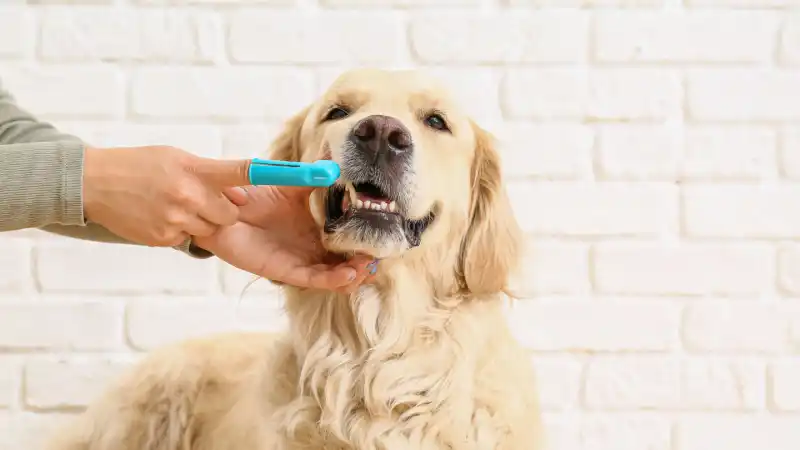Dog Flu: Symptoms, Treatment, & Prevention
Canine influenza is highly contagious and potentially dangerous for dogs. Learn more about dog flu symptoms, diagnosis, treatment, and prevention.

Canine influenza (dog flu) is a virus that can cause upper and lower respiratory infections in dogs. Currently, two strains of the virus found in the United States can lead to infection. H3N8 was first discovered in Florida in 2004, and the second strain (H3N2) didn’t reach the U.S. until an outbreak occurred in Chicago in 2015. Both strains have now spread to multiple states. As we have learned from the COVID-19 pandemic, viruses can change or mutate, which is what happened with these two flu strains.
The H3N8 strain is closely related to the horse flu and H3N2 developed from the avian (bird) flu. Both strains are easily transmitted from dog to dog, and at this time, they are the only two known strains that cause canine influenza. In some cases, the H3N2 strain has been reported to spread from dogs to cats. Currently, there is no evidence that canine influenza can spread from dogs to humans, and no human infection has ever been reported.
Canine Flu Symptoms
All dogs are susceptible, and transmission occurs through coughing and sneezing. It may also be transmitted from contaminated surfaces and clothing. Once infected, a dog’s symptoms can range from mild to severe.
Mild Symptoms
Most dogs will show mild upper airway symptoms resembling other upper respiratory infections. The general symptoms include runny nose, eye discharge, cough, decreased appetite, and lethargy (decreased energy). The cough may be moist or dry and typically lasts 10-30 days. Most mild canine influenza infections are self-limiting, meaning treatment is not usually necessary because symptoms resolve on their own. In fact, some dogs may show no sign of infection. Treatment recommendations are rest, conservative supportive care, and isolating in the home to prevent viral transmission to other dogs. The isolation period varies from 7-28 days depending on the strain, and your best bet is to create a plan with your veterinarian. Pet owners should also practice good hygiene as they can carry the virus on their body and clothes, which increases the risk of spread to other dogs (and cats) in the home.
Severe Symptoms
While most cases are mild, sometimes the infection can become severe and spread into the lower airways, or the lungs, becoming pneumonia. In severe infections, dogs are at high risk for developing secondary bacterial pneumonia. Dogs that fall into this category may have high fevers, difficulty breathing, extreme lethargy (marked decrease in energy), and a severe cough. These dogs typically require hospitalization with intensive supportive care including IV fluids, antibiotics, close monitoring, and oxygen therapy.
Canine Influenza Treatment
If your dog is showing any signs of influenza, it is best to contact your veterinarian and schedule an appointment. Due to the highly contagious nature of this virus, most veterinary practices have protocols in place to protect their other patients. These protocols vary and some practices even have a specific exam room designation for contagious pets. The veterinary team may wear protective gowns and masks during the visit. All precautions are taken to try to prevent the spread of the virus in the hospital.
Once your dog is checked in, your veterinarian will review their history and possible exposure points. They will also perform a full exam, which includes listening to the lungs and checking for a fever. Since canine influenza shares symptoms with many other upper respiratory diseases, your veterinarian may want to send out a lab test to try to identify the exact organism causing the infection. Tests can vary depending on the lab that your vet uses, but many offer entire upper respiratory panels. These more comprehensive panels are designed to test for several common upper respiratory infections, such as canine influenza (H3N8, H3N2), Bordetella, mycoplasma, and others.
Like human COVID testing, many tests require a swab from the nose or back of the throat. Your veterinarian will know the best test for your dog and which samples to collect. At the end of the visit, they will provide recommendations for necessary treatments, home care options, and the ideal isolation period. They may also recommend further diagnostic screening tests, such as chest x-rays and more detailed blood tests to determine how severely your dog is affected by the disease. And, if your dog is really sick or dehydrated, hospitalization will likely be recommended.
Prevention of Dog Flu
There are vaccines for canine influenza that can be administered by your veterinarian. Currently, most veterinarians only recommend the influenza vaccines for dogs that have a high risk of exposure. Dogs who have many contact points with other dogs are at more of a risk. High contact situations include boarding and grooming facilities, dog shows, agility trials, and frequent trips to dog parks or “meet ups.” Your vet may also recommend the vaccine if you live in an area with an active outbreak of influenza. For example, Los Angeles County in Southern California had 1284 confirmed cases between the months of July and December 2021. Thus, dogs in this area may have a higher risk of infection. If your dog is not at high risk or your area has not had many cases, your vet may not recommend the vaccine at all.
Vaccination may be helpful in preventing severe disease. However, your dog could still experience symptoms, since vaccines don’t guarantee that your dog will not become infected. Here is Merck Animal Health’s Nobivac bivalent vaccine statement:“Reduces the incidence and severity of coughing and decreases the overall clinical signs of disease, including ocular and nasal discharge, coughing, sneezing, depression, and dyspnea.”
Most professional veterinary organizations recommend vaccinating for canine influenza based on lifestyle and risk. The American Animal Hospital Association (AAHA) and the American Veterinary Medical Association (AVMA) list the vaccine as a lifestyle vaccine. The best way to determine whether your dog’s lifestyle requires the canine influenza vaccine, or any other non-core vaccines, is to schedule a visit with your veterinarian. Your local veterinarian will be your best source for informing you of all core vaccines (those that are recommended for all dogs) versus non-core vaccines, which are best determined by your dog’s lifestyle and chance of exposure. Your veterinarian will also have access to data concerning infections in your local area, as state veterinarians and large veterinary labs do provide data on current and emerging infectious diseases. Here is a link to AAHA’s vaccine recommendations, but it’s still best to talk to your primary care veterinarian about whether or not the influenza vaccine makes sense for your dog.
Take some of the stress out of pet ownership with Accident & Illness Coverage from AKC Pet Insurance (underwritten by Independence American Insurance Company). Our pet insurance plans are designed to be there when you need them, allowing you to focus more on the health of your pet and less on costly veterinary bills. Click here for a quote today!
Dr. Preston Turano graduated from the University of Illinois College of Veterinary Medicine in 2002. Since that time, he has been a Veterinarian, Medical Director, and Practice Owner.
READ MORE ARTICLES

